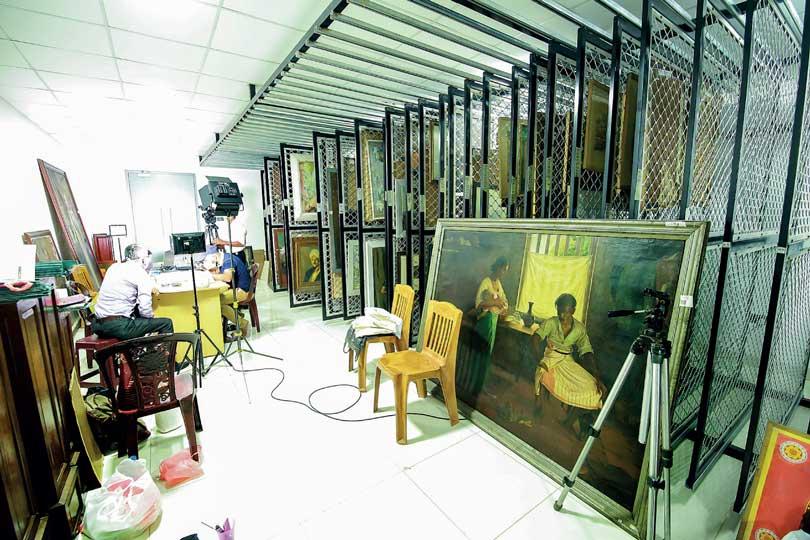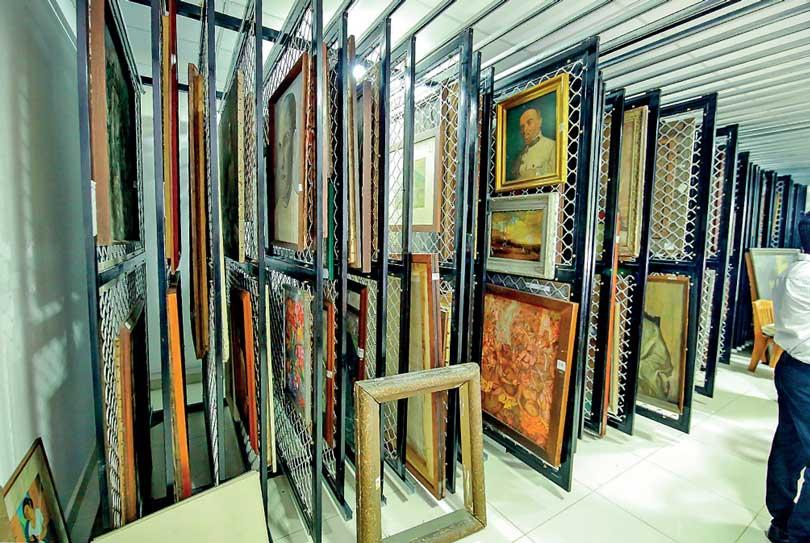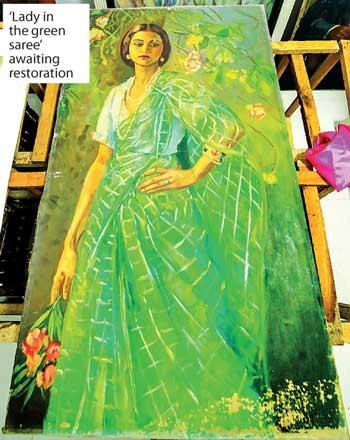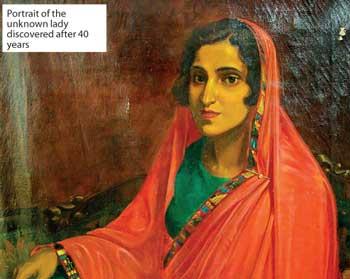Reply To:
Name - Reply Comment


Inside the conservation room
 Sri Lanka’s National Art Gallery closed its doors to the public in 2013, much to the dismay of contemporary artists and art lovers in the country. But ending its period of dormancy, this national asset, housing collections of versatile artists including George Keyt, Mudliyar A. C. G. S Amarasekara and so forth, is now undergoing a rapid transformation. With a total investment of Rs. 1.8 million, allocated by the Central Cultural Fund, the National Art Gallery is being transformed into a more accommodating space, housing a permanent collection as well as a new wing for emerging artists to showcase their talents. With the support of an international easel painting conservator, the team of experts is now in the process of conserving the artworks before putting them up on display next March.
Sri Lanka’s National Art Gallery closed its doors to the public in 2013, much to the dismay of contemporary artists and art lovers in the country. But ending its period of dormancy, this national asset, housing collections of versatile artists including George Keyt, Mudliyar A. C. G. S Amarasekara and so forth, is now undergoing a rapid transformation. With a total investment of Rs. 1.8 million, allocated by the Central Cultural Fund, the National Art Gallery is being transformed into a more accommodating space, housing a permanent collection as well as a new wing for emerging artists to showcase their talents. With the support of an international easel painting conservator, the team of experts is now in the process of conserving the artworks before putting them up on display next March.

“Factors such as type of artworks, their conditions and size would be looked in to. Out of them, there was a portrait of a national icon, Ananda Samarakoon that caught my eye. In conservation we always look at the back of a painting as there is more information than what is at the front”-
Jennifer Myers easel painting conservator
A concerted effort
The common objective of this team of versatile conservators, artists and scientists is to restore the masterpieces. “The Gallery was closed for around eight years, but it will be open to the general public with a curated show,” said Prof. Jagath Weerasinghe, contemporary artist and archaeologist. “For this task, an advisory committee was established comprising myself, Prof. B. D Nandadeva, Prof. Susiripala Malimbada and several others. When we were looking into the paintings we realised that they were not in their best shape. Some paintings are over a hundred years old. Some were done in 1830s and some in the 1930s. Some of these paintings were done by Mudliyar Amarasekara, who was the most important painter at the time.” said Prof. Weerasinghe.
These artworks serve a greater purpose than just being mounted on a wall. “Some of them are included in the Advanced Level arts curriculum and therefore, students have to see them and as such, this gallery cannot be closed forever,” he added.
 Myers (left) at work
Myers (left) at work
Continuous requests to successive government failed, but this time, their request has been heard. The leadership of Tharani Gamage, Director at the Department of Cultural Affairs, Hiranthi Fernando, Curator at the National Art Gallery and the expertise of Jennifer Myers, an easel painting conservator, has been the core of this transformation.
Despite Sri Lanka’s rich history of arts and culture, expertise on easel painting conservation wasn’t available. “For the first time in this country we have a programme for easel painting conservation. When it comes to conservation it was only about conserving Sigiriya murals, Buddhist murals etc. But this is a different kind of expertise. We are all trained in wall painting conservation – I have been responsible for Sigiriya murals and Dalada Maligawa paintings – but we have never worked on oil paintings or never trained for that. Although we have translated our experiences into this field, we don’t have the expertise,” Prof. Weerasinghe further said.

“When we were looking into the paintings we realised that they were not in their best shape. Some paintings are over a hundred years old. Some were done in 1830s and some in the 1930s. Some of these paintings were done by Mudliyar Amarasekara, who was the most important painter at the time”-
Prof. Jagath Weerasinghe contemporary artist and archaeologist
Inside the conservation room
 The conservation room, more aptly called the sanctum sanctorum of the Gallery, is a hive of activity, where all masterpieces are awaiting a facelift. While Myers was carefully examining each and every artwork in detail Prof. Weerasinghe showed us some of the paintings that needed immediate retouching. Most artworks had withstood the test of time and what is quite significant is that new discoveries are being made along the process. A painting of a lady in a green saree for example is mentioned in the curriculum as ‘the lady in a blue saree’. Therefore, a revision in the Arts curriculum too is required.
The conservation room, more aptly called the sanctum sanctorum of the Gallery, is a hive of activity, where all masterpieces are awaiting a facelift. While Myers was carefully examining each and every artwork in detail Prof. Weerasinghe showed us some of the paintings that needed immediate retouching. Most artworks had withstood the test of time and what is quite significant is that new discoveries are being made along the process. A painting of a lady in a green saree for example is mentioned in the curriculum as ‘the lady in a blue saree’. Therefore, a revision in the Arts curriculum too is required.
“Nobody understands the time required for easel painting conservation. But Prof. Nandadeva and I knew how difficult it was. It’s a unique expertise. Thereafter Prof. Nandadeva wrote to the Delaware University and that’s how we invited Jennifer to work with us. All these decisions were taken within a week. Then we had to look at presenting these artworks and for that, a committee comprising artists, conservators and scientists was formed. Even though we had years of experience in wall painting conservation we had to translate that experience to do first-aid easel painting conservation. Another challenge was discovering new paintings. Now there’s a new painting to the collection, but we don’t know the story behind it,” said Weerasinghe
40 years later …
Myers is an experienced easel painting conservator and a National Endowment for the Humanities Conservation Fellow at the Chrysler Museum of Art in the United States. Having worked on paintings by Edward Mitchell Banister for example, this experience, outside her homeland is a first for Myers. “One thing that I was going to do with these artworks was a survey so each one of them gets a little bit of time and attention,” she said in an interview with the Daily Mirror. “Factors such as type of artworks, their conditions and size would be looked in to. Out of them, there was a portrait of a national icon, Ananda Samarakoon that caught my eye. In conservation we always look at the back of a painting as there is more information than what is at the front. During the examination I realised that the weave of the fabric was different. When I investigated a little further I felt that there was some space in between,” said Myers.
Contrary to the portrait which was a horizontal painting, the presence of another landscape painting was felt. “Usually you expect to see dust settled at the bar due to gravity. But at the back, dust was settled on the sides. This was unusual. Thereafter I took off the tacks and we spotted a painted surface underneath the original painting. We then removed it from the painting we already knew and just like that, a new painting was discovered, almost 40 years later,” explained Myers.
The painting was done by Mudliyar Amarasekara and this portrait of an unknown lady now remains a mystery leaving several questions unanswered. Who is she? Why was it painted? Why was it underneath another painting and why wasn’t it destroyed are questions that have long been buried. The time difference between the new painting and the one of Ananda Samarakoon is said to be 25 years.
Spotlight on easel painting conservation
Shedding more light on her expertise, Myers opined that there are a lot of similarities and differences between wall painting conservation and easel painting conservation. “Most of these artworks have suffered a lot of damage over the past few years. This is one of the challenges as there’s a lot of work to be done within a limited time frame. Flaking paint for example should be stabilised, so that the original artwork is not affected. The restoration work should not impact the stories of these artists. The biggest challenge was to see what could be done to best present them, but also preserve them at the same time so that they could be kept longer. Training people on less glamorous factors such as protecting them from the environment, storing and hanging these artworks also takes time and a lot of effort,” added Myers.
 For Myers, each painting has its own story and therefore doesn’t attempt to generalize what each painting needs as they have been done by different people, at different times and each painting has had a different life. “However, there’s a lot of positive energy and excitement to share this collection with the public and those are the driving factors to keep things moving forward,” she added.
For Myers, each painting has its own story and therefore doesn’t attempt to generalize what each painting needs as they have been done by different people, at different times and each painting has had a different life. “However, there’s a lot of positive energy and excitement to share this collection with the public and those are the driving factors to keep things moving forward,” she added.
Based on her research and findings, the expert committee aims to propose the establishment of a Central Conservation Laboratory for future conservation purposes. Already, several concept notes too have been written to international counterparts.
While the artworks are being conserved by the expert committee, a parallel restoration of this national asset is currently underway. The labour for its physical facelift has been deployed by the Sri Lanka Navy. The management aims to open its doors to the public in March 2022. The main hall will comprise 70 permanent paintings while the Eastern Hall, closer to the Nelum Pokuna theatre will be rented out for private exhibitions, thereby providing a space for local and international artists to showcase their creativity.
Pix by Damith Wickramasinghe